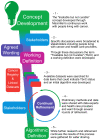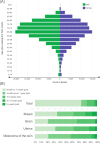Treatable but not curable cancer in England: a retrospective cohort study using cancer registry data and linked data sets
- PMID: 33419907
- PMCID: PMC7798682
- DOI: 10.1136/bmjopen-2020-040808
Treatable but not curable cancer in England: a retrospective cohort study using cancer registry data and linked data sets
Abstract
Objectives: This study estimates the prevalence of cancers that are categorised as treatable but not curable (TbnC) in England. It provides a quantification of the population and a framework to aid identification of this group to enable the design of tailored support services.
Design: Through consultation with clinical and data experts an algorithmic definition of TbnC was developed. Using cancer registry data sets, with five other linked data sets held by the National Disease Registration Service, the algorithm was applied as part of this retrospective cohort study to estimate the size and characteristics of the TbnC population.
Setting and participants: The health data records of 1.6 million people living with cancer in England in 2015, following a cancer diagnosis between 2001 and 2015, were retrospectively assessed for TbnC status.
Results: An estimated 110 615 people in England were living with TbnC cancer at the end of 2015, following identification of TbnC cancer between 2012 and 2015. In addition, 51 946 people fit the initial search criteria but were found to have been in their last year of life at the end of 2015 and therefore considered separately here as end of life cases. A further 57 117 people in England were initially identified as being at high risk of recurrence or having their life being shortened by cancer but did not fit the TbnC conceptual framework and were excluded, but their results are also reported under 'group B'.
Conclusions: A population living with TbnC cancer can be identified using data currently collected on a national scale in England. This large population living with TbnC cancer requires personalised treatment and support.
Keywords: health policy; oncology; public health.
© Author(s) (or their employer(s)) 2021. Re-use permitted under CC BY-NC. No commercial re-use. See rights and permissions. Published by BMJ.
Conflict of interest statement
Competing interests: None declared.
Figures





References
-
- Carlson M. Living scan to scan. Cure, 2018.
MeSH terms
LinkOut - more resources
Full Text Sources
Other Literature Sources
Medical
